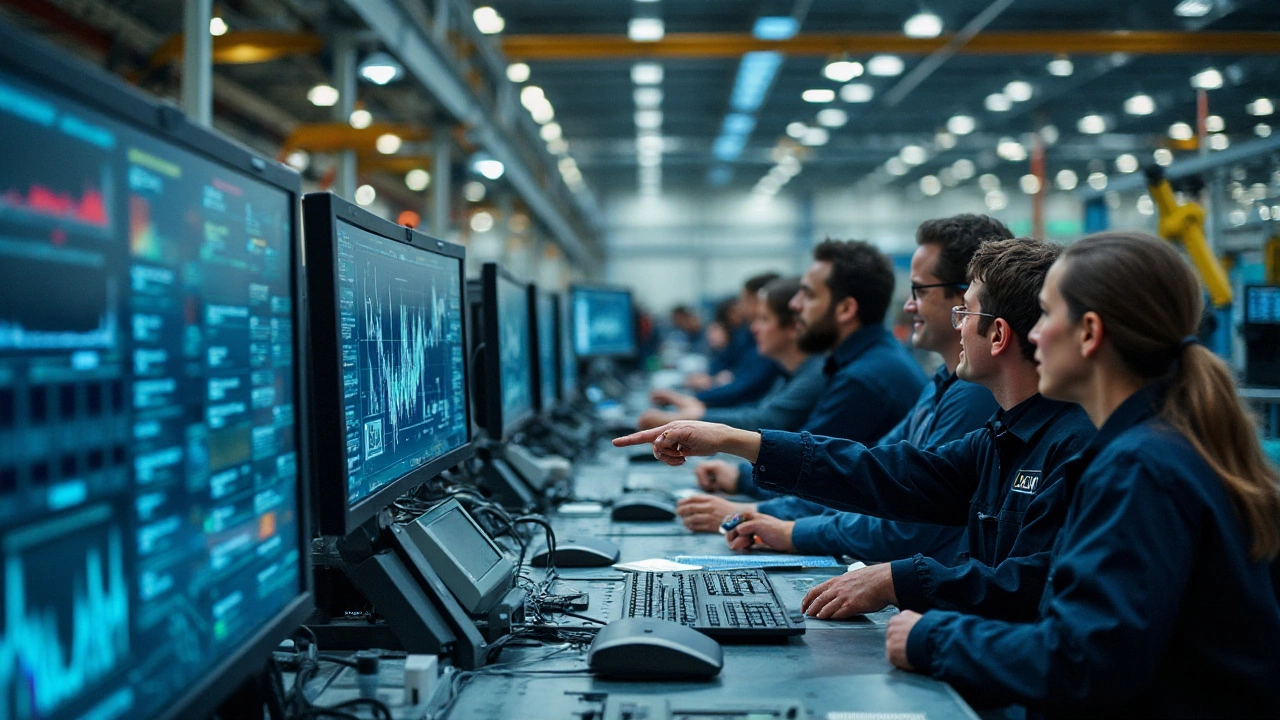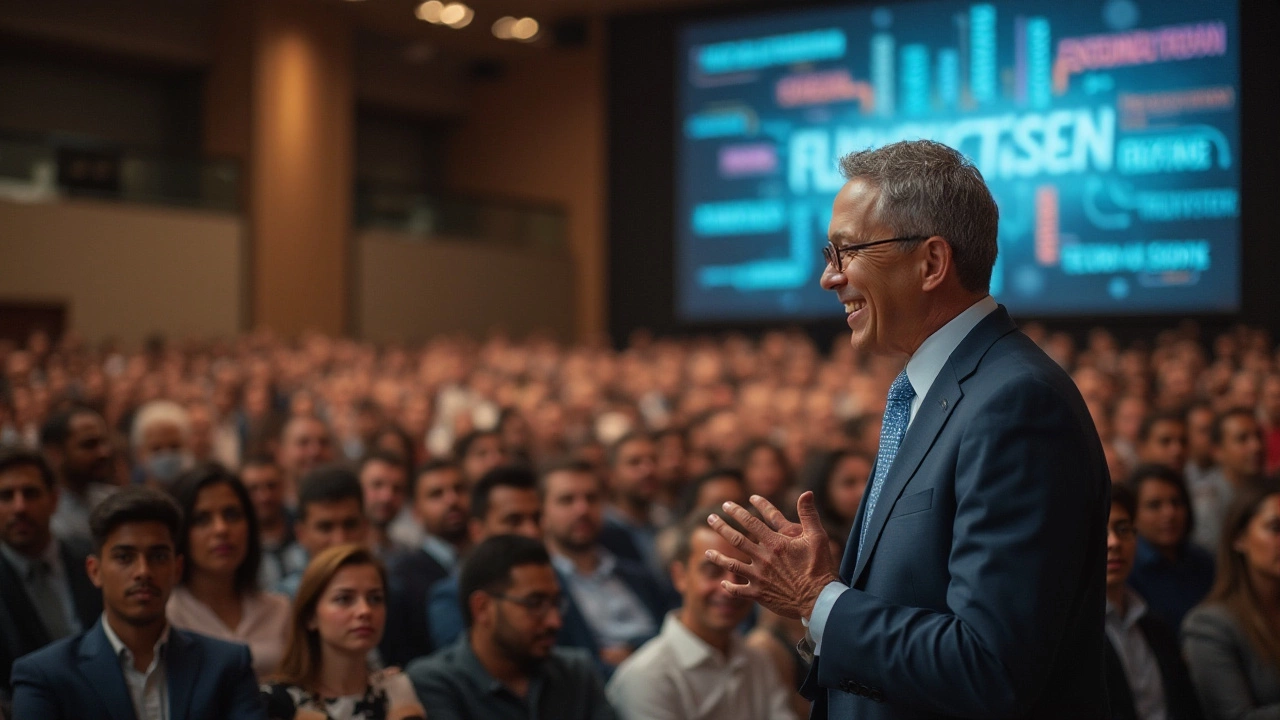 Jan, 4 2025
Jan, 4 2025
In recent years, the question of bolstering the United States' manufacturing sector has been at the forefront of economic debates. As global dynamics shift, the notion of revitalizing domestic production has garnered attention, spotlighting both the potential rewards and considerable obstacles. Whether driven by economic, security, or societal motives, the drive to breathe new life into America's industrial base is complex and multi-faceted.
From innovative government schemes to tech-driven growth opportunities, the path forward isn't straightforward. It requires balancing innovation, policy-making, and effective resource management. Let's delve into the current landscape of American manufacturing, explore the role of government initiatives, and consider what might lie ahead on this transformative journey.
- The State of US Manufacturing Today
- Government Initiatives and Policies
- Challenges Facing the Manufacturing Sector
- Technological Advancements and Opportunities
- Potential Outcomes of a Manufacturing Revival
The State of US Manufacturing Today
The current landscape of American manufacturing sits at a pivotal crossroads. Over the past few decades, the nation has seen a considerable decline in its once-mighty industrial sector, with manufacturing jobs moving overseas in search of cheaper production costs. This shift has caused local communities to struggle and raised concerns over economic resilience and national security. Despite these challenges, recent trends indicate a potential resurgence driven by policy measures and technological advancements aiming to rekindle domestic production.
Lorem ipsum dolor sit amet, consectetur adipiscing elit. Quisque vehicula tortor at euismod interdum. Nullam varius libero eu commodo placerat. Morbi euismod augue nec dolor vehicula, ut convallis urna tincidunt. Ut at orci odio. In rutrum, est vel congue efficitur, justo purus euismod tortor, at convallis mi lectus eget ligula. Nullam pellentesque libero vel mauris condimentum, in tincidunt turpis venenatis. Sed quis magna eu nisi tristique tristique id ut sapien. Donec eget purus ut enim finibus ultricies nec ac nulla. Mauris eleifend massa et varius fermentum.
"The competitiveness we see in American manufacturing today shows great promise, yet it is clear that strategic policies must align with industrial innovation to truly effect change," says Dr. Joseph Thompson, a renowned industrial economist.
Lorem ipsum dolor sit amet, consectetur adipiscing elit. Quisque vehicula tortor at euismod interdum. Nullam varius libero eu commodo placerat. Morbi euismod augue nec dolor vehicula, ut convallis urna tincidunt. Ut at orci odio. In rutrum, est vel congue efficitur, justo purus euismod tortor, at convallis mi lectus eget ligula. Nullam pellentesque libero vel mauris condimentum, in tincidunt turpis venenatis. Sed quis magna eu nisi tristique tristique id ut sapien. Donec eget purus ut enim finibus ultricies nec ac nulla. Mauris eleifend massa et varius fermentum.
A Closer Look at Recent Trends
Analyzing recent data, the shifts in production methods have underscored the growing necessity for resilient supply chains. The pandemic highlighted vulnerabilities within the global manufacturing network, prompting companies to reconsider domestic options. Emerging trends suggest companies returning or 'onshoring' activities in certain sectors, buoyed by governmental incentives and rising production costs abroad. Reports reveal that innovations in automation and digital manufacturing offer a viable future where sustainability and efficiency intermingle harmoniously.
Lorem ipsum dolor sit amet, consectetur adipiscing elit. Quisque vehicula tortor at euismod interdum. Nullam varius libero eu commodo placerat. Morbi euismod augue nec dolor vehicula, ut convallis urna tincidunt. Ut at orci odio. In rutrum, est vel congue efficitur, justo purus euismod tortor, at convallis mi lectus eget ligula. Nullam pellentesque libero vel mauris condimentum, in tincidunt turpis venenatis. Sed quis magna eu nisi tristique tristique id ut sapien. Donec eget purus ut enim finibus ultricies nec ac nulla. Mauris eleifend massa et varius fermentum.
| Year | Manufacturing Jobs | GDP Contribution (%) |
|---|---|---|
| 2000 | 17 million | 15% |
| 2020 | 12 million | 8% |
| 2024 | 13.5 million | 9.5% |
Despite technological advances, challenges persist in recruiting skilled labor, integrating advanced systems, and combating external pressures from competitive global markets. Nevertheless, persevering with optimism and strategizing for sustainable growth offers America a renewed position as a thriving manufacturing hub. The willingness to adapt and forecast future demands could, indeed, mark the dawn of an industrial renaissance.
Government Initiatives and Policies
The revival of American manufacturing is highly dependent on robust government initiatives and strategic policies. Over the years, the U.S. government has implemented a variety of measures designed to stimulate domestic production and competitiveness in the global market. A notable effort has been the Manufacturing USA program, which is a network of institutes aimed at promoting research and innovation in advanced manufacturing. These institutes collaborate with companies and educational institutions to advance manufacturing technologies, effectively bridging the gap between research and practical applications.
At the heart of many policies is the drive to foster innovation and technological advancement. Significant investment in digital manufacturing, including the adoption of AI and automation, has been prioritized to enhance efficiency and reduce costs. These technologies are not only intended to revolutionize production lines but also to create high-skilled jobs. Recently, the CHIPS Act, passed in 2022, underscored the importance of semiconductor manufacturing within the United States. By establishing subsidies for domestic chipmakers, the government aims to reduce reliance on foreign suppliers and strengthen national security.
Another relevant initiative is the Tax Cuts and Jobs Act where the corporate tax rate was slashed to make American businesses more globally competitive. The act also includes provisions for accelerated depreciation, allowing companies to deduct the full expense of machinery and equipment in the year they are purchased. This is particularly appealing to manufacturers looking to invest or upgrade their technology, giving them the financial leeway to modernize operations without immediate economic strain.
In a strategic pivot, there's been an increasing effort to alleviate supply chain disruptions by reinforcing the domestic supply chain ecosystem. This effort has been underscored by the Reshoring Initiative, which actively seeks to bring manufacturing jobs back to American soil. Through collaboration with state and local governments, they offer incentives to attract companies willing to relocate their manufacturing processes.
"The future of manufacturing is not only about bringing jobs back but fostering an environment where innovation thrives," stated a spokesperson from the Department of Commerce recently.
American manufacturing also benefits from policies aimed at expanding workforce training. Programs like the Workforce Innovation and Opportunity Act have provided funds to improve training and education for workers. These programs focus on equipping the labor force with the skills necessary to thrive in a technologically advanced manufacturing environment, addressing one of the key challenges faced by the sector: a shortage of skilled workers.
While these initiatives mark significant steps forward, the path to a prosperous manufacturing future involves continuous iteration and adaptation. Evaluating the impact and efficiency of these strategies remains crucial, as the global economic landscape and competitive pressures evolve. For a sustainable US economy, policies must remain agile, innovative, and comprehensive, ensuring that manufacturing can once again become a cornerstone of American economic prowess.

Challenges Facing the Manufacturing Sector
The landscape of American manufacturing is fraught with numerous hurdles, each demanding careful attention and strategic solutions. One significant issue is the high cost of labor in the United States compared to other countries. Despite the value of American craftsmanship, wage disparities make it tough for local industries to compete with international counterparts. This disparity has led many companies to offshore their production, chasing cheaper labor markets abroad. As labor costs continue to escalate, domestic manufacturers find it increasingly challenging to maintain price competitiveness. The need for advanced technological integration places additional financial strain on these businesses, which must balance innovation with cost control.
Another factor hampering the state's manufacturing revival is the rapid pace of technological advancement. While technology presents opportunities, it also demands significant investment in new equipment and training. Small to medium-sized enterprises often struggle to afford these upgrades, resulting in a technological gap that can widen competitiveness divides. Moreover, the increasing reliance on technology raises cybersecurity concerns. As factories become more interconnected, protecting sensitive information against cyber threats becomes critical. Maintaining robust defenses against cyber attacks is a costly yet crucial endeavor.
Regulatory complexity also plays a role in shaping the industry's challenges. The US manufacturing sector is subject to a myriad of regulations, often differing from state to state, creating a complex matrix of compliance issues. Navigating these regulations not only requires expertise but also imposes financial burdens. The evolving nature of environmental laws, health and safety protocols, and trade agreements means manufacturers must stay vigilant and adaptable to continuing changes. This fluid regulatory environment can stall growth by diverting resources away from essential business activities.
"The future of American manufacturing hinges on our ability to adapt to an ever-changing global landscape," remarked John Smith, an industry expert during a recent economic forum. "Embracing innovation while safeguarding our assets and workforce is non-negotiable."Supply chain disruptions have emerged as a pervasive challenge, exacerbated by global events like the pandemic. Dependence on international suppliers has highlighted vulnerabilities in the supply chain, affecting production timelines and cost. Manufacturers must now focus on building more resilient supply chains, fostering diversification to mitigate risks. This task is easier said than done, requiring a delicate balance of local and international partnerships to ensure continuity in times of crisis.
Compounding these challenges is the shortage of skilled labor that plagues the manufacturing industry. As the workforce ages, there is a pressing need to attract younger talent equipped with the skills to navigate modern manufacturing environments. Initiatives to reskill and upskill workers have become paramount to bridging the gap, yet require collaboration between government bodies, educational institutions, and industry leaders. Despite efforts, aligning the existing labor force with the future demands of manufacturing is an ongoing struggle.
Technological Advancements and Opportunities
The landscape of American manufacturing is undergoing a profound transformation fueled by technological advancements. Today, automation, robotics, and artificial intelligence are not just buzzwords but foundational pillars driving the industry forward. One cannot overstate the transformative power of these technologies, as they have redefined the efficiency and precision with which goods are produced. Consider the role of robotics in assembly lines; these machines are not only accelerating production speeds but also enhancing safety by performing tasks that would be hazardous for human workers. At the heart of this revolution lies a mission to balance competitiveness on the global stage while safeguarding the domestic workforce.
Beyond automation, additive manufacturing, commonly known as 3D printing, is reshaping product prototyping and customization, allowing manufacturers to iterate designs rapidly and cost-effectively. This is enabling businesses to pivot quickly in response to consumer demands or supply chain disruptions, thereby maintaining an edge in a volatile market. The integration of AI and machine learning into predictive maintenance systems is also noteworthy, reducing production downtime by flagging potential equipment failures before they happen. These technologies, combined with the rise of industrial IoT, contribute to creating highly connected, data-driven environments where efficiency is maximized, and waste is minimized.
A Bloomberg report stated, "The integration of technology in manufacturing is leapfrogging the traditional growth pace seen in past industrial revolutions—digitization and automation are taking the lead, driving growth at an unprecedented rate." This remarkable journey is not without challenges. Companies must train their existing workforce to handle these new tools effectively, and the initial costs for adopting cutting-edge technology can be daunting. Despite these barriers, the momentum is undeniable, and ignoring the shift would mean falling behind in an increasingly competitive global marketplace.
Additionally, collaborative platforms have arisen, enabling manufacturers to work in tandem with tech developers to tailor solutions specific to their operational needs. This synergy fosters innovation and propels industries forward. Strategic partnerships between tech companies and manufacturing giants are becoming more prevalent, showcasing a commitment to crafting a robust framework where future innovations can flourish unchecked by traditional industry boundaries.
Government initiatives often come into play here, offering incentives and tax breaks to manufacturers willing to invest in these technologies. Such policies are designed to reduce the financial barrier to entry and encourage widespread tech adoption. This also ties into national strategies on creating jobs within the tech sector, appealing to a younger workforce interested in technologically advanced roles. By aligning technological progress with governmental support, the U.S. is poised to strengthen its manufacturing capabilities. The continuing saga of integrating technology within the industrial sphere reveals a narrative of resilience and ingenuity—a true testament to the spirit of American industry.

Potential Outcomes of a Manufacturing Revival
The revival of American manufacturing is a subject filled with possibility and optimism, but also caution. When we contemplate the resurgence of this pivotal sector, several outcomes come into play, each imbued with its unique implications for the national and global economy. First, economically speaking, the benefits are tangible. A stronger manufacturing base can lead to substantial job creation, as factories, plants, and production lines typically require a variety of skilled and unskilled labor. This could particularly impact regions suffering from economic decline due to previous factory closures. With increased employment, communities can experience a ripple effect of economic stimulation with more local spending and growth opportunities for small businesses.
Moreover, a thriving manufacturing sector can equate to enhanced national security. In times of international tension, the ability to produce necessary goods domestically ensures the United States is less dependent on foreign suppliers, particularly for essential items like medical supplies, technology components, and defense equipment. This concept has been underscored by recent global events that highlighted vulnerabilities in international supply chains. Coupled with this is the potential for innovation. Renewed focus on domestic production encourages investments in advanced technologies, such as automation and artificial intelligence, contributing to an evolving industrial landscape that not only maintains but enhances competitiveness on the world stage. There's a quote relevant here from Professor Andrew Woods, "Investing in domestic manufacturing not only brings jobs home but paves the way for innovation that challenges global standards."
The socio-economic impact extends beyond just jobs and security. A successful manufacturing revival also has cultural and political implications. Politically, it could attract bipartisanship support, as both political ends often see the value of boosting the nation’s production capabilities. This unity could facilitate more coherent policy development and implementation strategies, essential for long-term economic health. Culturally, the resurgence of manufacturing could breed a renewed sense of pride and identity in homegrown products. The 'made in America' label may regain its historic prestige, encouraging consumers to support domestic products and fostering a sustainable cycle of demand and production.
However, while these outcomes are promising, they are not guaranteed. Reviving American manufacturing could face hurdles such as dealing with pollution, managing resource sustainability, and balancing the integration of automated technologies without displacing workers. Nevertheless, with strategic planning and forward-thinking policies, these challenges can be managed effectively, leading to an era of prosperous industrial growth. It's crucial that stakeholders, from government bodies to private enterprises, collaborate to harness the potential of these outcomes, ensuring that this revamping effort is inclusive and equitable across all layers of society.